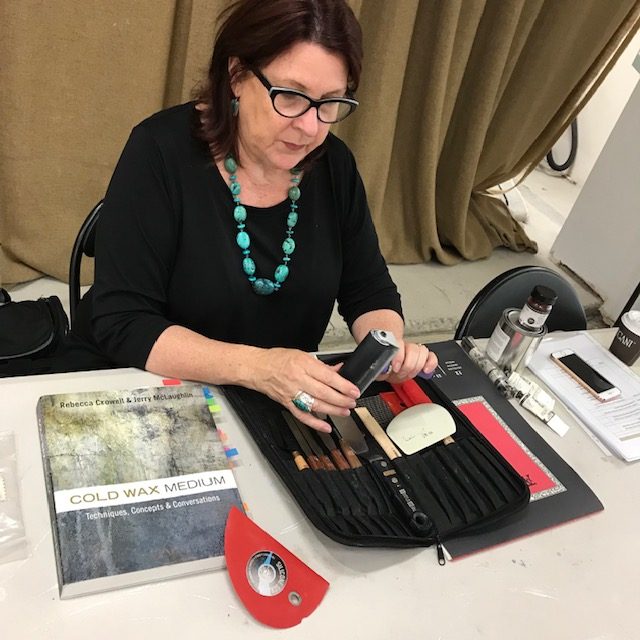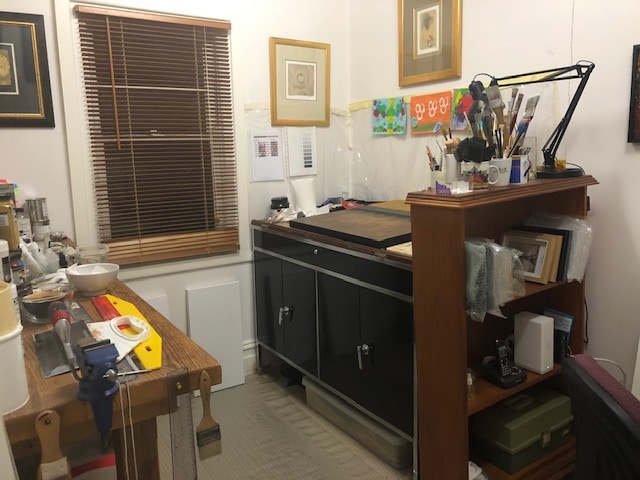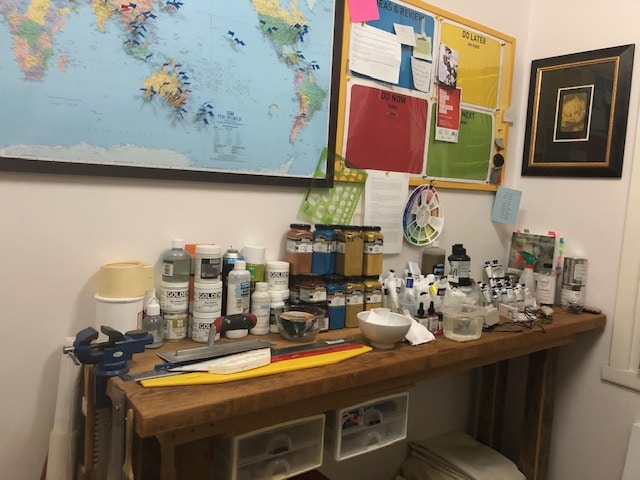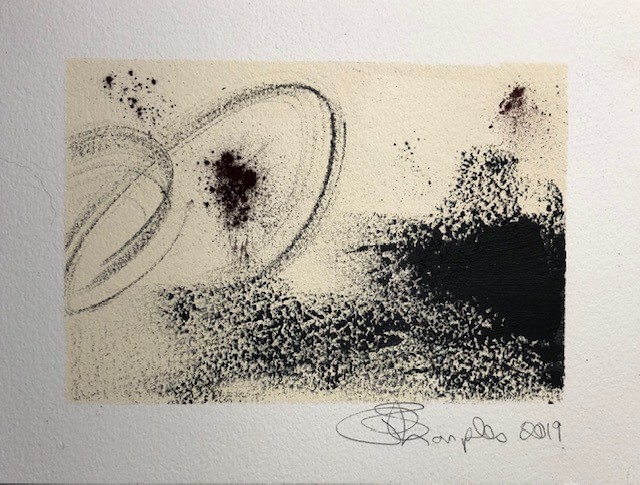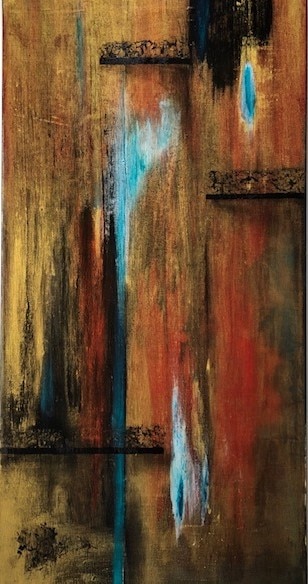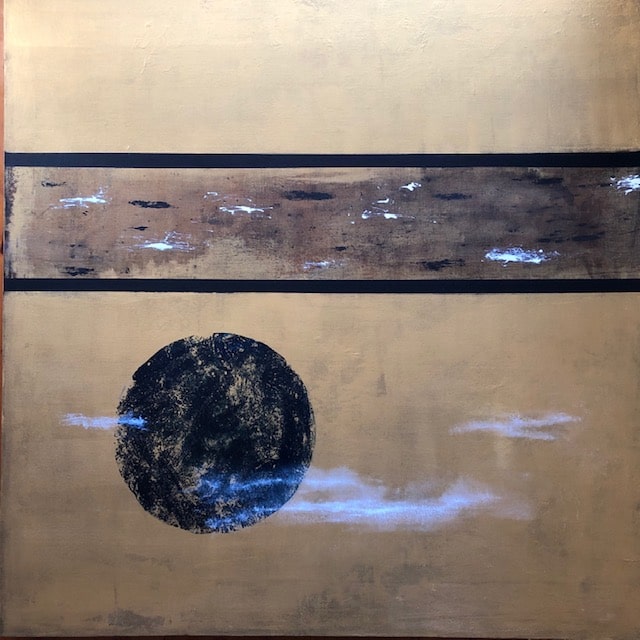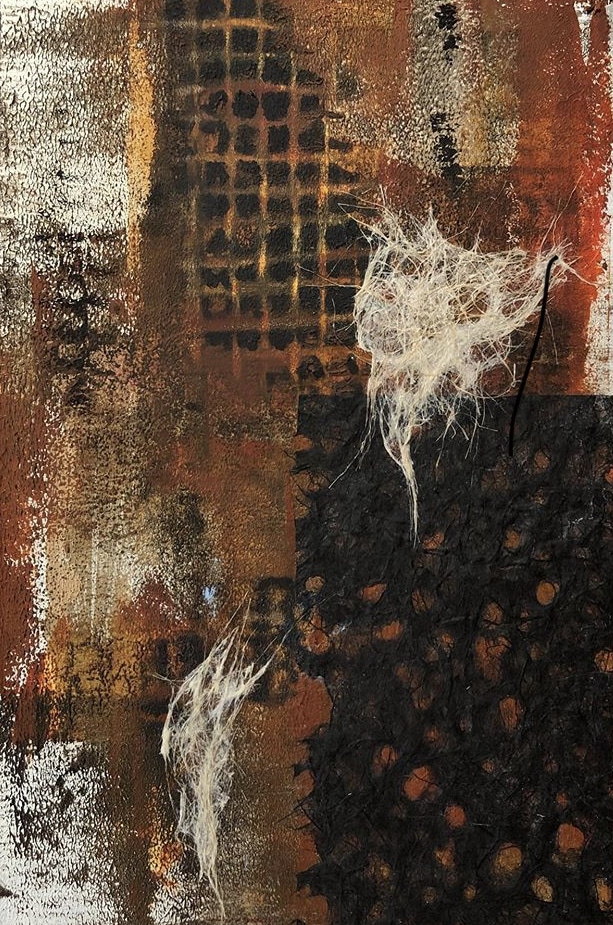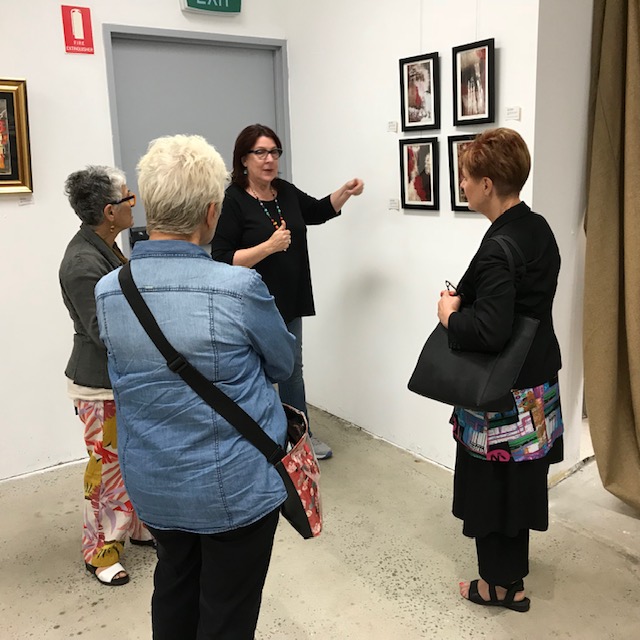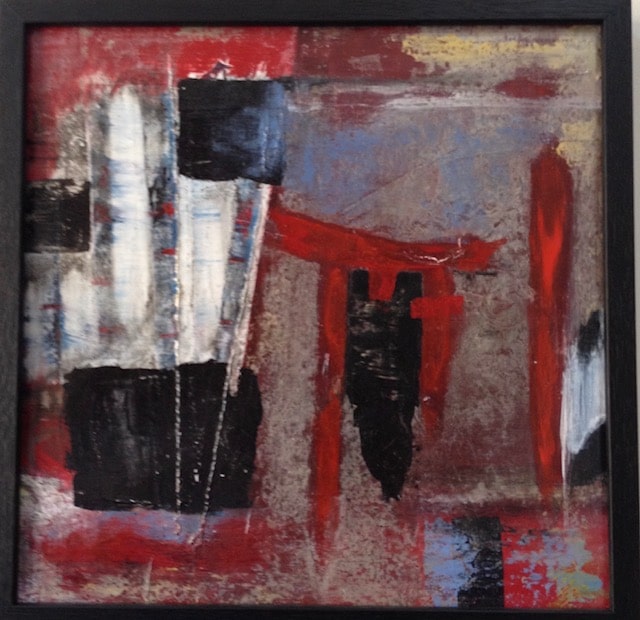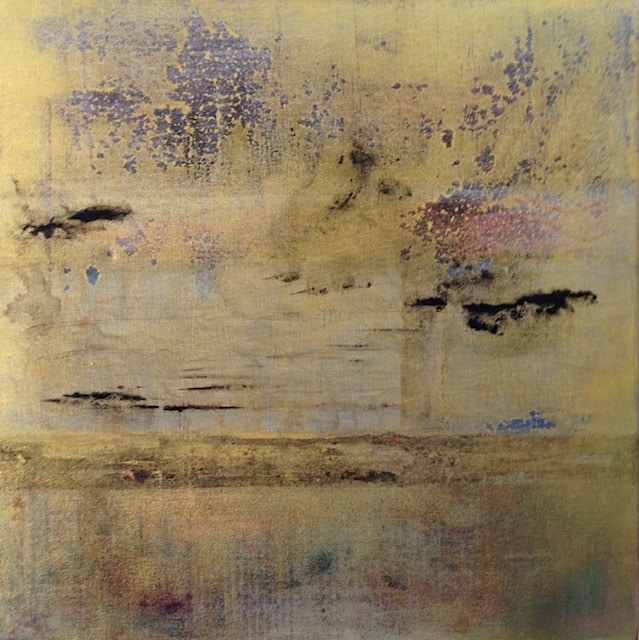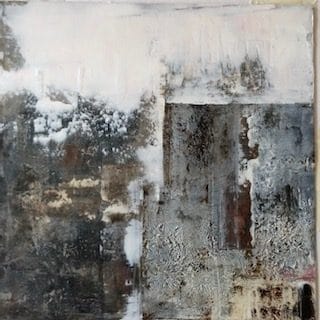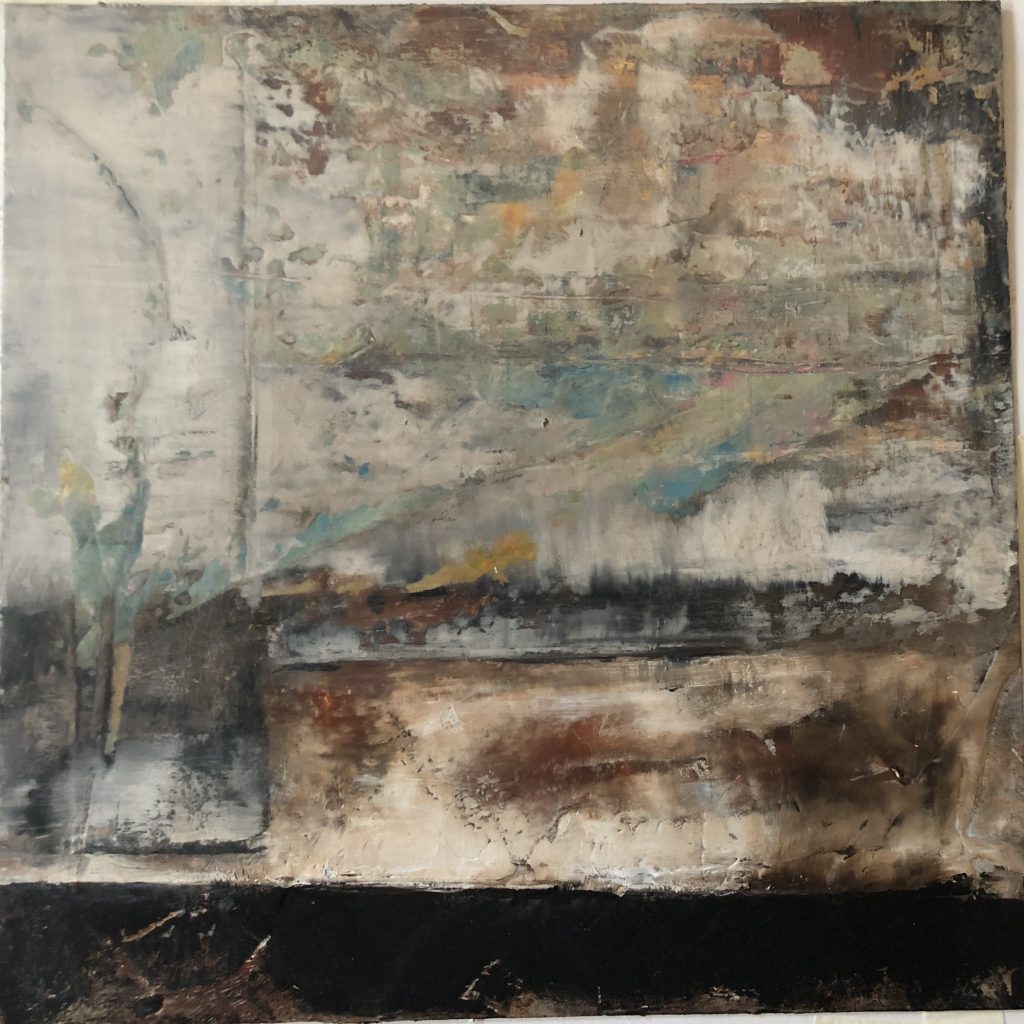Interview with Penny Sharples
Penny Sharples works in acrylics and in oil and cold wax. She was interviewed by Creativity Cluster facilitator Nancy Lane for the Melbourne City University of the Third Age (U3A) course Conversations with Artists on 2 March 2020. Excerpts from the interview follow, as well as photographs of Penny’s studio, artworks and workshops.
How does your art relate to who you are?
From a very young age I have always engaged in some form of creative endeavours. I felt a deep desire to paint, but I had not always given it the space it deserved. When I was preparing to step away from full-time employment, I decided it was time to follow one of my adolescent dreams. That’s when I started my journey to become an artist.
What role does your art play in your life?
It took some time to fully own my identity as artist, but I have come to realise it is significant. After family, friends and health, my art is the most important factor in my life. It provides nurturance for my soul and spirit and for my overall wellbeing.
Where do your inspiration and your ideas come from?
My travels have been a huge influence on my art. In my early years, I spent considerable time traveling and working in Asia. I am inspired by the Japanese aesthetic, which has influenced several of my painting series.
Greece is another place that I have returned to many times. I love to walk the land and explore Greek myths and the archaeological sites where the myths took place. I find the culture and food irresistible. My latest series was inspired by my recent trip to Greece. It will be exhibited at Without Pier Gallery in Cheltenham in March and April this year.
I’m inspired by many artists past and present. One of my favourite artists is Frenchman Gustave Moreau (1826-1898), who was also influenced by classical mythology. Rebecca Crowell has had a huge influence on me. She has been an awesome teacher in oil and cold wax painting.
My art is also inspired by my experiences of being in nature and feelings from my dreams. My works as an abstract artist are representative of experience and feeling, not a replication of an object or image. If I do include an image, it tends to be more impressionistic than literal.
What are the challenges for your creative process?
It’s important for me to trust in the process. I have to let the paint ‘do its own thing’ and follow its lead, as opposed to pushing the paint into some preconceived image. This has been my greatest challenge. Learning to play and go with the flow has been so liberating.
The second challenge has been learning to handle my inner critic. Hmm! Maybe that’s my biggest challenge.
What keeps you motivated and inspired?
I’ve always been pretty self-motivated in most things. What has been really helpful is understanding my creative rhythms. What I mean by this is that I know when I’m ready to paint and when the desire is not present.
I paint in short bursts, which works well with the layering style of my art. I may pop into my studio several times a day, sometimes for as few as 20 minutes. Having a studio at home makes this possible. In addition I have developed a creative plan which helps keep me focused and on track.
I’m in regular contact with a wide community of fellow artists and creatives around the world. I enjoy visiting galleries, taking advantage of short courses at places like U3A and Chapman and Bailey, reading about other artists and browsing online. All of these endeavours keep me inspired and motivated.
What trajectory did you follow to get to your current techniques?
It has been a wonderful journey, with many twists, turns and diversions. I‘m enthralled with the way serendipity and divergent ideas have come together. That assisted me to arrive at this place today.
Throughout my life I have dabbled in various pursuits, such as landscape design and jewellery design and fabrication. However, as I was preparing to step away from full-time employment, I decided to return to my art, which I had abandoned for some time.
This is where the serendipity comes into play. I had just started a short work contract, and one of the managers suggested I have a look at a YouTube video on the Power of Vulnerability by American researcher and academic Brene Brown. I was so impressed by her video that I purchased her book, Daring Greatly.
In the book she referred to her friend Nicholas Wilton. I loved what he wrote about how perfectionism crushes creativity. I was not so much attracted to his art, but to his ideas about art practice, which is more than just the painting techniques.
So I wrote to him. As it turned out, he was just about to launch his online art course based on his Artplane method. I joined up for the six month online program. That program confirmed for me that I wanted to pursue my art above all else. I packed all my other projects away and set up my studio in the old lean-to laundry.
How did this course change your approach to art?
Nicholas’s course also introduced me to a worldwide network of artist. A couple of his guests were American artists Jerry McLaughlin and Rebecca Crowell. I was enthralled and intrigued by Rebecca’s art, as I had never heard of painting with oil and cold wax. I just had to learn about this method.
However, I could not find oil and cold wax courses in Australia, so I checked out Rebecca’s courses. After three years, I finally got accepted to study with her in an intensive residential program in Ireland. By chance I had recently discovered my Irish heritage. The two passions converged, and so I headed off to Ireland.
In March I’m hoping to head off to San Miguel De Allende in Mexico. My plan is to study with Rebecca and Jerry, focusing on the power of contrast in art. I also want to tour around Mexico, Peru and Easter Island, as inspiration for three art exhibitions on my return.
What ideas are you trying to convey in your work?
I try to convey the inner expression of my feelings and thoughts, which words can’t convey. My aim is to create artworks that inspire viewers to reflect on the bigger questions and narratives of their lives.
What is a typical day’s work in your creative process?
I go into my studio every day, even if I don’t paint. It is part of my practice just to be in my studio. Sometimes I potter, tidy up, play with the materials. This will often lead to actually painting.
My studio is the old lean-to laundry. It’s tiny, but it’s just off the lounge room. When the creative urge comes upon me, I can easily access this wonderful space. My art will sometimes spill over into the lounge room, especially when I’m working on large canvases. On average, I’ll be in my studio several times a day.
What do you do to keep motivated to work on your own?
As I live alone this is not a problem. I don’t have many distractions, apart from a very gorgeous but demanding cat.
What is the medium you work in and what drew your interest to that medium?
Over the years I have tried many mediums. When I completed the course with Nicholas Wilton, we used acrylic. I now use that mainly for my Japanese-inspired art.
When I came across the work of Rebecca Crowell, I knew I wanted to get those effects in my work. After studying with her, most my work is now in oil and cold wax. I love this medium; it’s so visceral, a joy to paint. Occasionally I work in mixed media.
How do you cope with exposing your work to the public?
I found this difficult initially. In 2002 I contributed to an exhibition, and one of the other artists was rather disparaging and condescending. I didn’t exhibit again until 2017.
Since then I have become more robust. I made up my mind that I had to paint what was important to me, regardless of the critique. If my art resonates with someone and they wish to own it, that’s a plus. It’s not the impetus for me to paint, though.
Is it hard to be criticised?
Oh yes, at times I’ve found it hard, particular when I was younger. I’ve had some tough comments. However, I’ve come to learn that sometimes those hard comments say more about those who are commenting.
Nonetheless, it is important to get objective feedback. I have chosen an art curator I trust to provide feedback, which has been very helpful.
Because my art does not fall into the popular commercial category, it’s bound it have its critics and dissenters. These days I’m a bit more philosophical about my work and not as precious. I think I’m a harsher critic of my work than other people. Indeed, I think most artist are.
Do you treat art like a job? If so, in what ways?
No, I don’t treat it like a job, but I do take my art practice seriously. I have a 10-year creative plan, like a business plan. This keeps me on my path and enables me to track my progress. My plan has four key goals: continuous learning; a significant portfolio of work; an international art profile; and financial neutrality.
Can you make a living at art?
Yes, and many artists do. But like any commercial enterprise, you have to put in the effort to make it work. This is often a dilemma for artists. It creates tension between the time to paint and the time required to market and promote their work.
Creatives have to work out for themselves how they are going to financially support their art. It helps if they are clear about its place in their life. Is it a hobby they budget for? Do they expect to sell enough so that it funds itself? Or is it their primary source of income? Creatives each have to develop a strategy to get the right outcomes for themselves.
In the book by Elizabeth Gilbert, called Big Magic: Creative Living Beyond Fear, she writes about the vows she made to her writing. In the book she says “that I would never ask writing to take care of me financially – meaning I would always take care it”.
I found these words very powerful. It assisted me in identifying the aspect of my life that was detracting from my creative process.
I’m thrilled when I sell my art. My aim is for my art to eventually support itself. However, I’m willing to support it for as long as required. I don’t want my creative light to be snuffed out by financial demands.
How do your market your work?
I’m still experimenting with the best way to get my work into the public arena. I’m listed on Gallery 247, which is an online art selling platform. I also email updates on new works to friends, family and people who have purchased my art.
I also participate in the Creativity Cluster community art exhibitions and have established an Instagram account just for my art. Actually, that is how I met Nancy. She was conducting a course on Upskilling Your Art. She taught us how to set up our Instagram accounts and she started the Creativity Cluster art group.
I have my first significant exhibition coming up in March at Without Pier Gallery, which is very exciting. I will be exhibiting 16 pieces inspired by my recent study trip to Greece.
What parts of your past art would you keep and what parts would you let go?
The joy of being in my studio is something I always want to keep. I love it when I’m in a timeless state of play, with no attachment to the outcome. However, I still need to do some work on my inner critic.
Describe the art you will be making in 3 years.
My hope is to develop a recognisable style that is uniquely mine. I would like to start working on larger pieces, but will require access to a larger studio.
